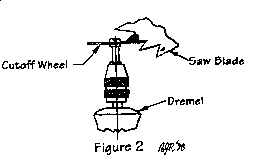 |
TIPS |
 |
TIPS |
SELECTING and SHARPENING SLOTTING SAW BLADES
Most saw blades for cutting wood have several things in common. They all have teeth with set in them (some planer blades excepted) and the teeth are ground at an angle and have a set which produces a cut or kerf wider than the blade thickness.If you wish to buy a small circular saw blade (1.0 to 2.5 inches in diameter), you will be forced to consider slotting or jeweler's blades, which are primarily intended for cutting metals. Most have very fine teeth. They are made of high speed steel alloy and are heat treated. The teeth are cut square across and have no set. These blades will cut a kerf that is the same width as the blade thickness. Cutting depth is usually kept very shallow to keep heat buildup to a minimum.
To select a blade for cutting wood, it is important to select one that is coarse rather than fine. Ideally, the tooth-to-tooth spacing should be from 3/16 to ¼ inch as shown in figure 1. Fine tooth blades are mainly useful for shallow, cross cuts. If you examine catalogs of blades, you will find that blades with coarse tooth spacing are difficult to find.
To use these blades for cutting wood I have found it necessary to sharpen them in a manner similar to that of wood cutting blades. The techniques described here is crude but it works for me. The accuracy is at best a guess. It takes some practice to become proficient at this, but it is not too difficult to master.Tools required: A Dremel tool with speed control, a mandrel and some cutoff wheels (7/8" dia. X 0.020" thick), and a magnifying eyepiece.
On the side of the blade, mark the teeth as shown in Figure 1 with a marker that will not rub off during handling. Use a larger mark at one tooth as shown, as this will be your starting point. The other marks are so you will not lose your place during the grinding step. Now turn the blade over and do the other side, but this time, the marks go on the teeth that you did NOT mark on the opposite side.
 Now, get yourself in a
comfortable position with both elbows resting on a table or bench top, and holding the
Dremel in a vertical position with the abrasive wheel at eye level, you are now ready to
begin sharpening. Be sure to take appropriate safety precautions!
Now, get yourself in a
comfortable position with both elbows resting on a table or bench top, and holding the
Dremel in a vertical position with the abrasive wheel at eye level, you are now ready to
begin sharpening. Be sure to take appropriate safety precautions!

 Now proceed to grind the
faces of the teeth in the same manner as you did the tops of the teeth. After grinding the
faces of the teeth. Your blade should now appear as shown in Figure 4 when viewed from
either side.
Now proceed to grind the
faces of the teeth in the same manner as you did the tops of the teeth. After grinding the
faces of the teeth. Your blade should now appear as shown in Figure 4 when viewed from
either side.

